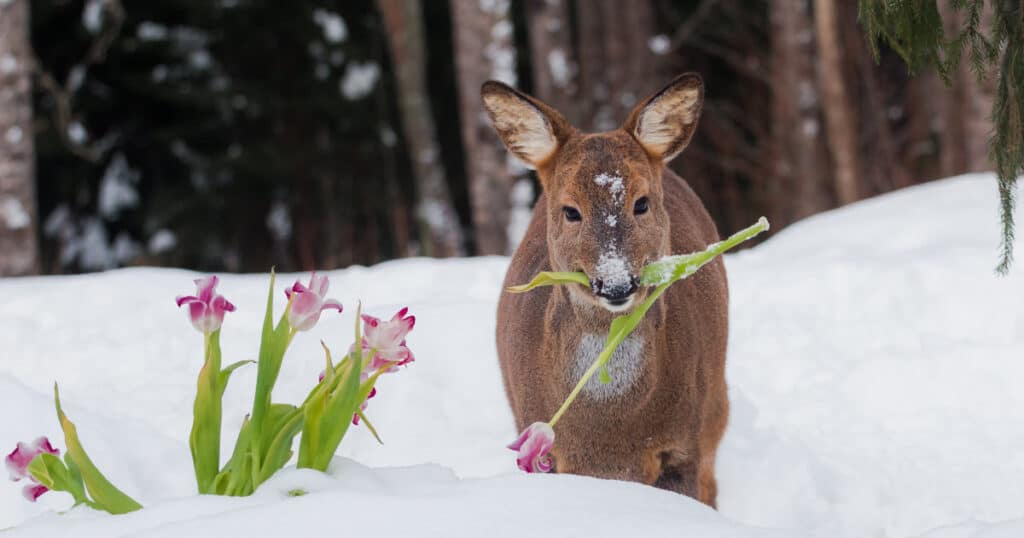Many different kinds of critter will raid your garden if they get the chance. It may surprise you, but one of those is quite large: the deer. Deer won’t usually come into gardens during the day. Instead, they will wait until nighttime. But which of your plants are safe and which are most at risk? Do deer eat tulips? In this article we’ll explain the dietary habits of deer and provide some tips to keep your tulips safe from hungry deer.
As these animals eat large amounts of vegetation every day, they can demolish all of this year’s gardening work very quickly. They’ll eat your roses, hydrangeas, peonies, and yes, even your tulips!
Do Deer Eat Tulips? (Answered)
Yes, deer certainly do eat tulips. This shouldn’t be all that surprising, as deer seem to eat every kind of vegetation imaginable. Deer especially love new green leaves of tulip and other kinds of bulb plants that emerge in spring when vegetation is still limited. If you live in a suburban or rural area where deer have been spotted, your tulip garden is at risk.
Which Parts of the Tulip Will Deer Eat?
Deer will eat all parts of the tulip plant. However, the part they usually eat first is the new green leaves that appear before the flowers even begin. The leaves of tulips contain a lot of moisture and are very attractive to deer.
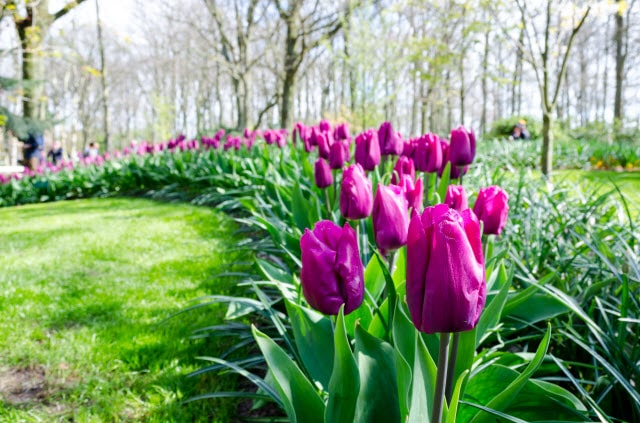
The bad news is that when deer eat the green leaves, there is generally nothing left to provide the energy needed for flower growth. That means your garden will be bare.
What Happens if Deer Eat Your Tulips?
If a deer eats the leaves of your tulips before flowers can be generated, there probably won’t be enough energy left in the plant for them to grow later.
If you don’t start from scratch and plant new bulbs, you won’t have any flowers this year. However, if you do have some remaining foliage, you should try to rehabilitate it as much as you can.
As the foliage continues to develop, more may show up above the soil line. If enough grows back, you might have enough of a foundation for flowers to appear the following year.
You can try applying some water soluble fertilizer and water carefully. Don’t make the soil soggy, but keep it consistently moist.
How to Keep Deer Away from Your Tulips
Keeping deer away from your tulips is a tricky task. That is because these animals find these bulb flowers so delicious. Having a tall fence will be very helpful. Make sure it’s not too short, or the deer will just leap over it.
Putting chicken wire on the area will protect the leaves but only until they are a few inches long. As soon as they get through the wire, however, deer will be able to eat them.
Luckily, there are several other things you can do to keep deer away from your tulips. Whatever methods you use, it’s best to use more than one and change them periodically.
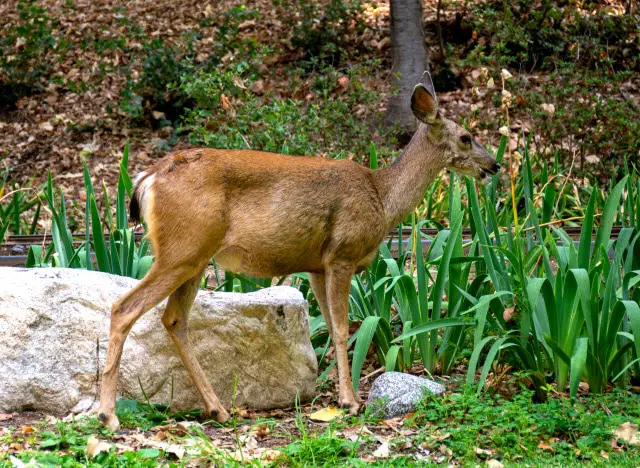
That is because deer will get used to your deterrents, and might find your tulips too tempting to stay away.
Your Options to Repel Deer
Let’s take a look at some ways you can keep deer away from your tulips:
- Install elements such as windmills, motion detection lights, chimes, and other things that will keep away skittish deer (at least for a while).
- Plant some herbs with strong scents. Deer will probably dislike the smell and stay away. Catmint is a nice choice – it looks beautiful in spring, is pollinator-friendly, and creates a nice front of the border splash of color in front of your tulips. You can also try planting prickly plants.
- Think about adding some plants to distract the deer from your tulips. Of course, you will need to be ready for the deer to eat these.
- Set up sprinklers with a timer or buy one that detects motion and turns on when deer are present. If using a timer, make them go off during times when deer are most active and looking for food, which is usually dawn and dusk. Deer are crepuscular.
- Sprinkle some spices and herbs in your garden. These may include onion, garlic, hot sauce, cayenne pepper, and red pepper flakes.
- Use an organic deer repellent. There are many recipes out there, including combinations of ammonium salts and capsaicin.
- Remember to use a mixture of deterrents and change them periodically. Try to combine repellents that use scent, motion, and taste, as well as barrier repellents. And after a heavy rain, you’ll want to re-apply.
- Surround your tulips with hairy or fuzzy foliage. Deer hate the feeling of this kind of foliage and will probably leave it they encounter it on your property. Some plants you could try include Siberian bugloss (Brunnera), lamb’s ear (Stachys), flowering tobacco (Nicotiana), purple top vervain (Verbena bonariensis), heliotrope, and lady’s mantle (Alchemilla).
- Plant prickly foliage around your tulips. Deer also dislike feeling anything sharp against their tongues. Some plants with pricky leaves include Cardoon, globe thistle (Echinops), bear’s breeches (Acanthus), and sea hollies (Eryngium).
Are there Deer-Resistant Tulip Varieties?
Yes, there are certain kinds of tulip that deer are less likely to eat. These include:
Tulipa Kolpakowskiana
Tulipa Kolpakowskiana is a lovely yellow tulip. Each bulb will produce either one or two stems. Each of the stems create up to two flowers.
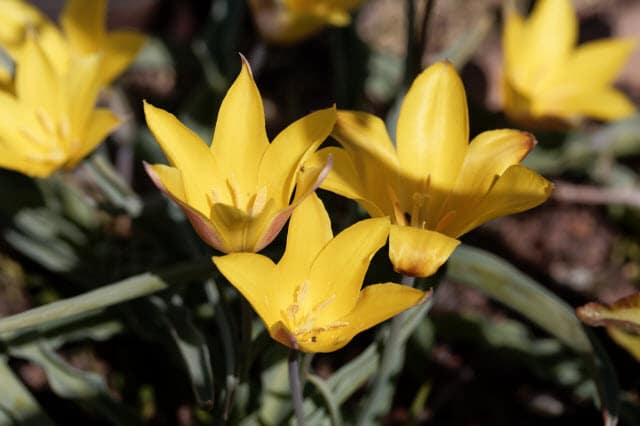
There is a soft touch of red on the outer part of the petals. This flower usually blooms in April of each year. The stem of each flower can be about eight inches in height.
Tulipa biflora
This is a tiny variety of tulip. It grows to a maximum of four inches tall. Tulipa biflora have a beautiful fragrance and are especially effective at attracting pollinators. Each Tulipa biflora bulb may produce as many as six flowers.
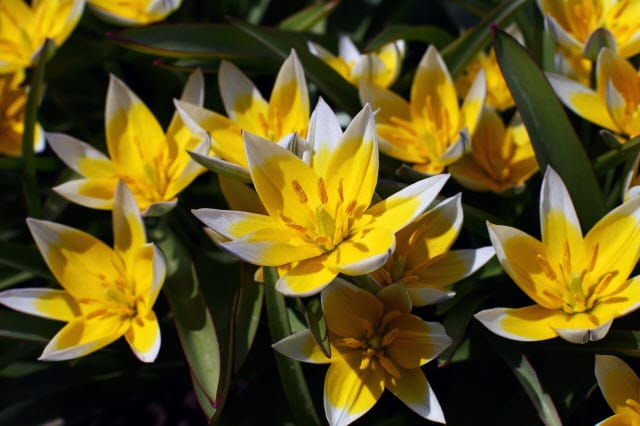
Tulipa biflora blossoms are white in color, and you will notice there is a green hue at the end of each petal. There is also a grayish lavender accent. A yellow patch adorns the base part of the blossom.
Daystemon
Daystemon is one of the rarer bulb tulips. While it’s similar to other bulbs in that it is able to bud in the way they usually do, it can also reproduce in the same way as strawberry plants.
When they do this, they use production of a stolon. Each Daystemon bulb leads to one or two flower stems, each about six inches tall. Each stem will produce between one and six flowers. The flowers of this plant are star-shaped.
Linifolia
Linifolia are small tulips that come in a brilliantly red shade. They have a dark black base.
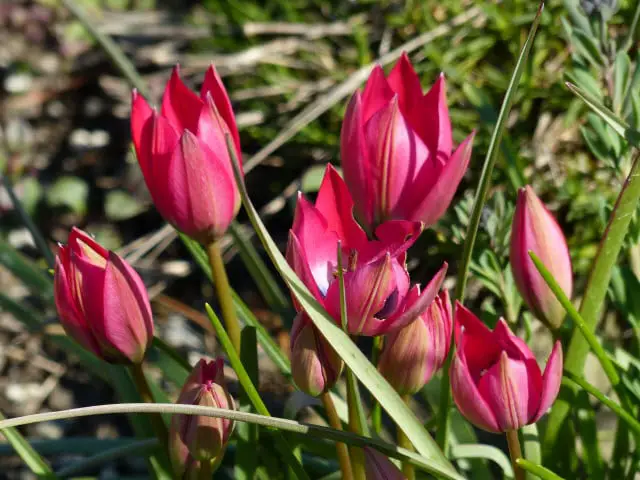
This flower was brought to the United States in the 1880s. The green leaves of Linifolia often have a burgundy edge.
Protect Your Tulips from Deer
Protecting your beautiful tulips from deer is essential if you live in an area with populations of that animal.
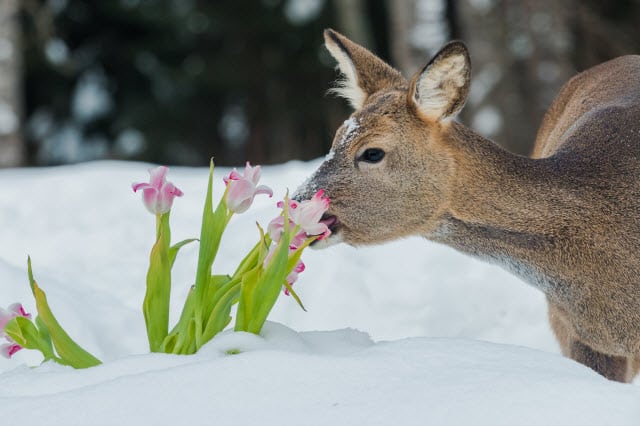
It can be one of the trickiest plants to protect from deer because tulips emerge so early in the season when deer are especially hungry (and more bold as a result).

